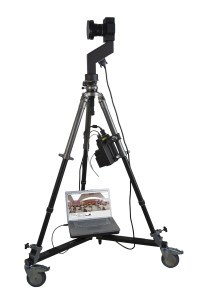From the Police Department’s perspective, Garland is in the same league as New York and Los Angeles.
That’s because Garland, like those two massive departments, owns a Panoscan panoramic camera. The camera, the first of its kind in Texas, gives investigators a fuller perspective on a crime scene – and the chance to take another look at it long after the cleanup crews have wiped away the area.
“It’s a really interesting tool,” said James Rogers, a Garland senior forensic investigator. “It’s not going to solve every crime, but in that one case, it might help.”
The Dallas Morning News reports the 46 mm camera allows investigators the chance to get and save a 360-degree view of a scene.
Rogers demonstrated the long-lens hook-shaped camera at a fake crime scene he set up in a parking lot behind police headquarters. The victim, a dummy, lay face-down on the pavement near a gun, a knife, a cellphone and an article of clothing.

The camera slowly spins around as it stitches together smaller images into one big photograph. In about six minutes, the camera dings. “Toast is done,” Rogers said with a chuckle.
On his computer with specialized software, Rogers drags around an image that shows him everything in the lot all at once. He can measure the distance between the objects. He can see how the cars were situated. He can see a spot of blood on the ground that he might have missed earlier.
The finished image gives detectives more chances to “go back and tour the room,” Rogers said.
Panoscan chief financial officer Casey Coss said the $95,000 camera is a step up from point-and-shoot pictures that detectives normally get.
“It’s an objective capture,” Coss said. “You’re not using a point-and-shoot camera that picks and chooses thing out of the crime scene.”
Garland investigators still go through their normal processes at the crime scene, including taking their own photos. But Rogers said the new technology helps their “ultimate audience” – the jury – get a better visual of an area.
Garland bought the camera in January 2012. The New York Police Department bought two and the Los Angeles Police Department has three, Coss said. No other department in Texas has one, he said.
Coss said his company demonstrated the camera for the Dallas and Fort Worth police departments, but didn’t get any bites.
Police departments weren’t the original customers. The company wanted to sell the cameras to provide virtual tours of houses, apartments and office buildings, Coss said.
“It was not well-received in the real estate industry,” Coss said. Practically speaking, people liked to see things in person. And the files were too large for the Web in the late ’90s and early 2000s.
The cameras could still be used to tour buildings, Coss said. A police department could take a virtual tour of buildings such as schools ahead of time. That way, if there is ever an active shooter inside, police and SWAT officers would be able to review the building layout and nuances before they go inside, Coss said.
But Garland police haven’t used the camera – which can be time-intensive to transport, set up and use – for that purpose yet. For now, they only plan to use the camera at homicide scenes and police shootings with self-contained crime scenes.
In fact, they’ve used it in only one actual case.
In July, an off-duty officer working a security shift at Wal-Mart saw Casey Smith, 31, leaving with several items he didn’t pay for. The officer tried to stop Smith, but couldn’t. He pulled a stun gun and fired. Smith turned around and charged at the officer with a crowbar, police said.
The officer shot Smith, who died later that night at a Dallas hospital.
Investigators at the scene got the word of Smith’s death when the camera was already slowly scanning the Wal-Mart parking lot. The case has not yet gone to a grand jury.
If the officer is indicted, the camera’s footage of the scene could be used at trial, Garland police spokesman Joe Harn said.
Despite its rare use, police officials say, the Panoscan is well worth it. Rogers said the camera aids his team’s goal, which “isn’t to say guilty or innocent. It’s to say what happened.”
Was this article valuable?
Here are more articles you may enjoy.

 Jane Street-Millennium Trade Secrets Fight Ends in Settlement
Jane Street-Millennium Trade Secrets Fight Ends in Settlement  US House Task Force Releases ‘Blueprint’ for Federal AI Responsibility
US House Task Force Releases ‘Blueprint’ for Federal AI Responsibility  CVS Accused of Illegal Opioid Dispensing in Whistleblower Suit
CVS Accused of Illegal Opioid Dispensing in Whistleblower Suit  Nearly 1,000 Feared Dead After Cyclone Hits France’s Mayotte
Nearly 1,000 Feared Dead After Cyclone Hits France’s Mayotte 